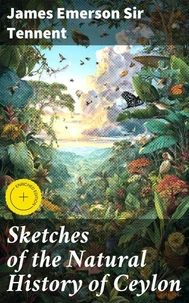Sketches of the Natural History of Ceylon
Par :Formats :
Disponible dans votre compte client Decitre ou Furet du Nord dès validation de votre commande. Le format ePub est :
- Compatible avec une lecture sur My Vivlio (smartphone, tablette, ordinateur)
- Compatible avec une lecture sur liseuses Vivlio
- Pour les liseuses autres que Vivlio, vous devez utiliser le logiciel Adobe Digital Edition. Non compatible avec la lecture sur les liseuses Kindle, Remarkable et Sony
 , qui est-ce ?
, qui est-ce ?Notre partenaire de plateforme de lecture numérique où vous retrouverez l'ensemble de vos ebooks gratuitement
Pour en savoir plus sur nos ebooks, consultez notre aide en ligne ici
- Nombre de pages492
- FormatePub
- ISBN859-65--4733477-4
- EAN8596547334774
- Date de parution16/09/2022
- Protection num.Digital Watermarking
- Taille2 Mo
- Infos supplémentairesepub
- ÉditeurDIGICAT
Résumé
James Emerson Sir Tennent's "Sketches of the Natural History of Ceylon" serves as a comprehensive exploration of the exquisite biodiversity and unique ecosystems of Sri Lanka, known historically as Ceylon. Published in the mid-19th century, Tennent's work intricately weaves vivid descriptions with meticulous observations, presenting an early scientific narrative enriched by Romantic literary style.
His narrative not only highlights the flora and fauna indigenous to the island but also immerses the reader in the geographical and sociocultural context of the time, reflecting both the colonial gaze and the emerging scientific inquiry of the Victorian era. As an entrenched figure in the colonial administration and a naturalist, Tennent possessed a keen awareness of the environmental dynamics of Ceylon.
His passion for natural history, alongside his role as a public servant in the region, led him to document the island's natural wonders. Tennent's background in medicine and his involvement in early scientific communities infused his writing with both rigor and enthusiasm, making his observations a significant contribution to the field. "Sketches of the Natural History of Ceylon" is not just a valuable scientific text; it is also an enthralling read for those interested in the intertwining of nature and colonial history.
I highly recommend this work to both budding naturalists and scholars alike, as it offers a foundational understanding of the natural heritage of Sri Lanka and the complexities of its historical context.
His narrative not only highlights the flora and fauna indigenous to the island but also immerses the reader in the geographical and sociocultural context of the time, reflecting both the colonial gaze and the emerging scientific inquiry of the Victorian era. As an entrenched figure in the colonial administration and a naturalist, Tennent possessed a keen awareness of the environmental dynamics of Ceylon.
His passion for natural history, alongside his role as a public servant in the region, led him to document the island's natural wonders. Tennent's background in medicine and his involvement in early scientific communities infused his writing with both rigor and enthusiasm, making his observations a significant contribution to the field. "Sketches of the Natural History of Ceylon" is not just a valuable scientific text; it is also an enthralling read for those interested in the intertwining of nature and colonial history.
I highly recommend this work to both budding naturalists and scholars alike, as it offers a foundational understanding of the natural heritage of Sri Lanka and the complexities of its historical context.
James Emerson Sir Tennent's "Sketches of the Natural History of Ceylon" serves as a comprehensive exploration of the exquisite biodiversity and unique ecosystems of Sri Lanka, known historically as Ceylon. Published in the mid-19th century, Tennent's work intricately weaves vivid descriptions with meticulous observations, presenting an early scientific narrative enriched by Romantic literary style.
His narrative not only highlights the flora and fauna indigenous to the island but also immerses the reader in the geographical and sociocultural context of the time, reflecting both the colonial gaze and the emerging scientific inquiry of the Victorian era. As an entrenched figure in the colonial administration and a naturalist, Tennent possessed a keen awareness of the environmental dynamics of Ceylon.
His passion for natural history, alongside his role as a public servant in the region, led him to document the island's natural wonders. Tennent's background in medicine and his involvement in early scientific communities infused his writing with both rigor and enthusiasm, making his observations a significant contribution to the field. "Sketches of the Natural History of Ceylon" is not just a valuable scientific text; it is also an enthralling read for those interested in the intertwining of nature and colonial history.
I highly recommend this work to both budding naturalists and scholars alike, as it offers a foundational understanding of the natural heritage of Sri Lanka and the complexities of its historical context.
His narrative not only highlights the flora and fauna indigenous to the island but also immerses the reader in the geographical and sociocultural context of the time, reflecting both the colonial gaze and the emerging scientific inquiry of the Victorian era. As an entrenched figure in the colonial administration and a naturalist, Tennent possessed a keen awareness of the environmental dynamics of Ceylon.
His passion for natural history, alongside his role as a public servant in the region, led him to document the island's natural wonders. Tennent's background in medicine and his involvement in early scientific communities infused his writing with both rigor and enthusiasm, making his observations a significant contribution to the field. "Sketches of the Natural History of Ceylon" is not just a valuable scientific text; it is also an enthralling read for those interested in the intertwining of nature and colonial history.
I highly recommend this work to both budding naturalists and scholars alike, as it offers a foundational understanding of the natural heritage of Sri Lanka and the complexities of its historical context.



